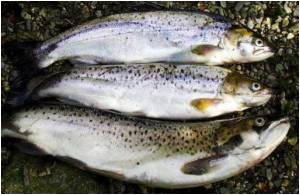Saltwater fish like tuna, mackerel and shark end up posing a more serious health threat to humans who eat them due to their mercury content

The potentially harmful version of mercury – known as methylmercury -- latches onto dissolved organic matter in freshwater, while it tends to latch onto chloride -- the salt -- in seawater, according to new a study by Heileen Hsu-Kim, assistant professor of civil and environmental engineering at Duke's Pratt School of Engineering.
"The most common ways nature turns methylmercury into a less toxic form is through sunlight," Hsu-Kim said. "When it is attached to dissolved organic matter, like decayed plants or animal matter, sunlight more readily breaks down the methylmercury. However, in seawater, the methlymercury remains tightly bonded to the chloride, where sunlight does not degrade it as easily. In this form, methylmercury can then be ingested by marine animals."
Methylmercury is a potent neurotoxin that can lead to kidney dysfunctions, neurological disorders and even death. In particular, fetuses exposed to methylmercury can suffer from these same disorders as well as impaired learning abilities. Because fish and shellfish have a natural tendency to store methylmercury in their organs, they are the leading source of mercury ingestion for humans.
"The exposure rate of mercury in the U.S. is quite high," Hsu-Kim said. "A recent epidemiological survey found that up 8 percent of women had mercury levels higher than national guidelines. Since humans are on the top of the food chain, any mercury in our food accumulates in our body."
The results of Hsu-Kim's experiments, which have been published early online in the journal Nature Geoscience, suggest that scientists and policymakers should focus their efforts on the effects of mercury in the oceans, rather than freshwater.
Advertisement
In the past, most of the scientific studies of effects of mercury in the environment have focused on freshwater, because the technology had not advanced to the point where scientists could accurately measure the smaller concentrations of mercury found in seawater. Though the concentrations may be smaller in seawater, mercury accumulates more readily in the tissues of organisms that consume it.
Advertisement
Mercury enters the environment through many routes, but the primary sources are coal combustion, the refinement of gold and other non-ferrous metals, and volcanic eruptions. The air-borne mercury from these sources eventually lands on lakes or oceans and can remain in the water or sediments.
The key to the sun's ability to break down methylmercury is a class of chemicals known as reactive oxygen species. These forms of oxygen are the biochemical equivalent of the bull in the china shop because of the way they break chemical bonds. One way these reactive oxygens are formed is by sunlight acting on oxygen molecules in the water.
"These reactive forms of oxygen are much more efficient in breaking the bonds within the methylmercury molecule," Hsu-Kim said. "And if the methylmercury is bonded to organic matter instead of chloride, then the break down reaction is much faster."
Source-Eurekalert








